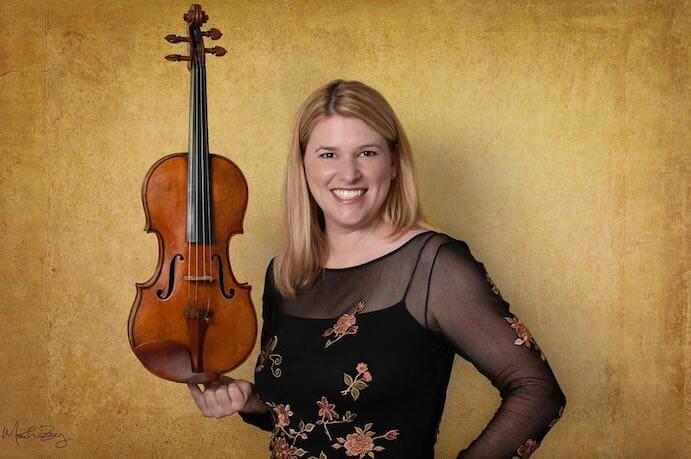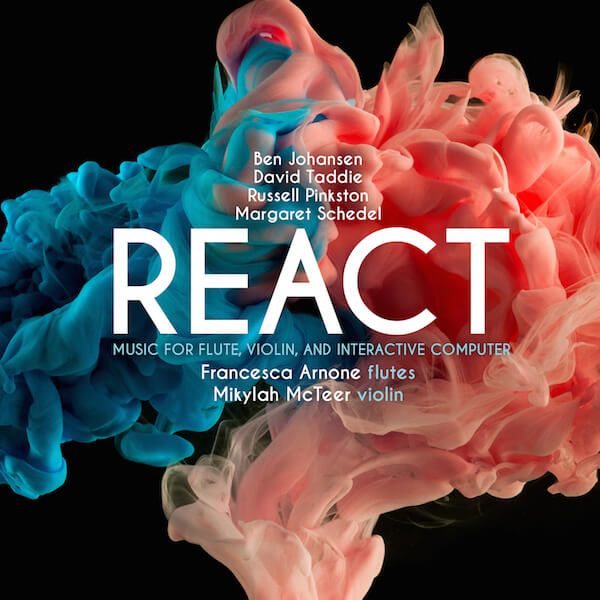For those who fear an impending “rise of the machines,” REACT (Ravello Records) offers some reassurance that freethinking automatons won’t be here any time soon. The album features violinist Mikylah McTeer and flutist Francesca Arnone as the sole human components in works composed by Ben Johansen, David Taddie, Russell Pinkston, and Margaret Schedel. REACT is the first collaborative album by McTeer and Arnone’s duo, “reACT,” an ensemble formed in 2009 and devoted to contemporary compositions. In each piece, electroacoustic accompaniment manipulates McTeer’s and Arnone’s sound; yet, as sophisticated these digital transformations may be, they do not seem to possess the generative capacities of the musicians. Flutist and violinist feed the computer their dynamic interactions, triggering mutations to the soundscape. The oft-unpredictable musicality that results is thus as much a testament to the computer’s feedback capabilities as to the musicians’ attentive improvisational skills.
REACT begins and concludes with Johansen’s interpretive compositions, Interact and React. A loosely written score guides both pieces; though, McTeer and Arnone freely play off each other’s dynamics, rhythms, and tempo. In Interact, Johansen provides a cornucopia of aural delights for his performers to work with: glissandos become ghostly and theremin-like and phrases overlap each other, dissipating and sputtering into the next. In React, computer algorithms record the musicians’ input, filtering different segments at seemingly random times throughout. Passages featuring brusque, pointillist notes serve the electronic accompaniment well, allowing the algorithm to freckle the atmosphere with punctuations. As indeterminate works, Interact and React are as much authored by Johansen as they are by the performers. Carefully managing their interactions, McTeer and Arnone effectively avoid triggering a viral cacophony from the computer: near the conclusion of Interact, the duo calculatingly ascend and descend their dynamics in flowing, repetitive figures, initiating a corresponding drone of placid accompaniment from the computer.

Mikylah McTeer
Luminosity and Category 5 (Echoes), written by David Taddie, persuasively marry the organic to the inorganic. Listening to Luminosity immediately sparked my nostalgia for the opening scene from Indiana Jones, Raiders of the Lost Ark, as Indy ventures to retrieve the iconic golden fertility idol from deep within the South American wilderness. Flanging and percussive reverberation effects, like festering buzzards, take the listener to dense tropical forests. Arnone masterfully juxtaposes this landscape with a vulnerable, lilting tone. The flutist’s unsettling transitions between rapid note clusters and more flowing, lyrical figures furthers the suspenseful environment. This is most notable at times of expanded silences—Arnone crescendos from faint stirrings in lower registers to louder, more anxious tones in higher registers. Joined by McTeer’s warm tonality, Category 5 (Echoes) is a much more hospitable setting than that of Luminosity. McTeer and Arnone perform alongside heavily-processed samples of their own acoustic sound, recorded previously by Taddie. These “echoes,” reshaped timbres of violin and flute, shimmer as the composer applies tremolo, phaser, and ring modulation effects—like a breeze on a wind chime. Together, Arnone and McTeer bestow life to their voices. McTeer effectively plays a more supportive role, at times arpeggiating steadily to Arnone’s soaring tones.
Like Johansen’s React, Pinkston’s Vox Clamantis and Lizamander feature autonomous live audio processing that saturates the musicians’ sound. Any musician who has performed in an ensemble has likely been scolded one time or another, that they never listen to their fellow orchestra members. It is clear from Vox Clamantis that McTeer and Arnone took those lessons to heart. As the two commence through the score, they activate a measured, steady electronic accompaniment that cannot itself adjust to their playing. In this way, McTeer and Arnone are both performer and accompaniment—with only each other to maintain balance. Nevertheless, the performers manage to match the electroacoustics with surgical precision. Lizamander for solo flute demands similar focus from the musician. Pinkston’s score offers guidelines for sixty-three “events” that direct the electroacoustic element. The computer initiates these moments when certain pitches are played. However, while many musicians might revel in the idea of their computer replacing an annoying stand partner, they will likely be disappointed. Considering his delicately tailored program, Pinkston warns performers of missed “events,” in which case the flutist must activate the computer manually. In the recording, it would seem Arnone is unfazed by this complication; her virtuosic passages command with authoritative solo power over the computer.

Francesca Arnone
Schedel’s contributions to REACT, QfwfQ and Partita, Perihelion are respectively named to recognize the composer’s inspirations. QfwfQ, the omniscient narrator featured in author Italo Calvino’s works, has experienced all of time and space in countless forms. Appropriately, Schedel’s piece employs a chorusing algorithm that multiplies the bottom line of the two-line score. Since the piece allows violinist and flutist to switch parts mid-piece, the additive chorusing background adopts an aggregation of both instruments’ timbres. McTeer’s and Arnone’s strategic voice-switching arrangement demonstrates the pair’s mastery of duet roles—with each subsequent part-swap, McTeer and Arnone transition between lyrical melodies and more rhythmic support. Partita, Perihelion represents Schedel’s techno-homage to Bach’s celebrated compositions for solo violin. One of the defining assets to Bach’s Partitas is disseminated melodic lines, performed simultaneously. In Schedel’s tribute, the violinist plays a scored, similarly polyphonic piece. Certain tones then electronically activate sustained pedal points that, combined, reveal their chordal harmony. Although the experiment offers an intriguing perspective on polyphonic composition, the computer-induced “harmonies,” for lack of a better word, stack-up an otherwise multi-melodic work. Presumably, it is with deference to Bach’s genius that Schedel exposes these harmonies to us: Bach’s Partitas weave melodies amongst each other in exquisite complexity.
While the cyborg musicians of REACT certainly illuminate the performances of fellow humans Mikylah McTeer and Francesca Arnone, it’s safe to say that they still need some handholding. Yet, as long as composers continue to devise such elaborate algorithmic cues, we can still be dazzled by new, undiscovered sonorities.




















